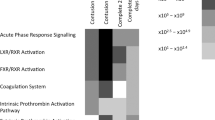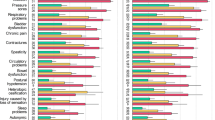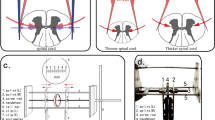Abstract
Study design:
Experimental, controlled trial.
Objectives:
The purpose of this study was to evaluate over a 15-day period alterations in sleep pattern of rats after spinal cord injury (SCI).
Setting:
Federal University of São Paulo, Department of Psychobiology.
Methods:
In total, 20 male Wistar rats were used. The rats were divided in two groups: SHAM and SCI. The rats were submitted to the following procedures: electrode insertion surgery, 24 h duration baseline sleep recording, SCI (level T9) and subsequent sleep recording for 15 consecutive days.
Results:
The results showed a reduction in sleep efficiency in the light period for Days 1–3, 5, 10 and 12 after SCI in relation to the SHAM group, with alterations in total waking time and sleep stages. Limb movements were observed 4 days after SCI.
Conclusion:
The present findings suggest that SCI may be heavily involved in altering sleep pattern in SCI subjects and that the inactivity caused by SCI may be exacerbating this altered sleep pattern.
Sponsorship:
Associação Fundo de Incentivo à Psicofarmacologia (AFIP), FAPESP (03/06297–3, and CEPID 98/143033) and CNPQ.
Similar content being viewed by others
Log in or create a free account to read this content
Gain free access to this article, as well as selected content from this journal and more on nature.com
or
References
Andersen ML, Tufik S . Sleep patterns over 21-day period in rats with chronic constriction of sciatic nerve. Brain Res 2003; 12: 84–92.
Esteves AM, De Mello MT, Lancellotti CL, Natal CL, Tufik S . Occurrence of limb movement during sleep in rats with spinal cord injury. Brain Res 2004; 13: 32–38.
Biering-Sorensen F, Biering-Sorensen M . Sleep disturbances in the spinal cord injured: an epidemiological questionnaire investigation, including a normal population. Spinal Cord 2001; 39: 505–513.
Ronsemberg RS, Bergmann BM, Rechtschaffen A . Variations in slow wave activity during sleep in the rat. Physiol Behav 1976; 17: 931–938.
Bergmann MB, Kushida CA, Everson CA, Gilliland MA, Obermeyer W, Rechtschaffen A . Sleep deprivation in the rat: II. Methodology. Sleep 1989; 12: 5–12.
Timo-Iaria C, Negrao N, Schmidek WR, Hoshino K, Menezes CEL, Rocha TL . Phases and states of sleep in the rat. Physiol Behav 1970; 5: 1057–1062.
Eljm VL, Aml C . An EEG averaging technique for automated sleep–wake stage identification in the rat. Physiol Behav 1984; 33: 837–841.
Budh Norrbrink C, Hultling C, Lundeberg T . Quality of sleep in individuals with spinal cord injury: a comparison between patients with and without pain. Spinal Cord 2005; 43: 85–95.
Sayaar K, Arikan M, Yontem T . Sleep quality in chronic pain patients. Can J Psychiatry 2002; 47: 844–848.
Morin CM, Gibson D, Wade J . Self-reported sleep and mood disturbance in chronic pain patients. Clin J Pain 1998; 75: 75–84.
Klefbeck B, Sternhag M, Weinberg J, Levi R, Hultling C, Borg J . Obstructive sleep apneas in relation to severity of cervical spinal cord injury. Spinal Cord 1998; 36: 621–628.
De Mello MT, Lauro FAA, Silva AC, Tufik S . Incidence of periodic leg movements and restless legs syndrome during sleep following acute physical activity in spinal cord injury subjects. Spinal Cord 1996; 34: 294–296.
De Mello MT, Silva AC, Rueda AD, Poyares D, Tufik S . Correlation between K complex, periodic leg movements (PLM), and myoclonus during sleep in paraplegic adults before and after an acute physical activity. Spinal Cord 1997; 35: 248–252.
De Mello MT, Silva AC, Esteves AM, Tufik S . Reduction of periodic leg movement in individuals with paraplegia following aerobic physical exercise. Spinal Cord 2002; 40: 646–649.
De Mello MT, Esteves AM, Tufik S . Comparison between dopaminergic agents and physical exercise as treatment for periodic limb movements in patients with spinal cord injury. Spinal Cord 2004; 42: 218–221.
Lindvall O, Bjorklund A, Skagerberg G . Dopamine-containing neurons in the spinal cord: anatomy and some functional aspects. Ann Neurol 1983; 14: 255–260.
Garcia-Garcia F, Ponce S, Brown R, Cussen V, Krueger JM . Sleep disturbances in the rotenone animal model of Parkinson disease. Brain Res 2005; 1042: 160–168.
Acknowledgements
This work was supported by grants from Associação Fundo de Incentivo à Psicofarmacologia (AFIP), FAPESP (03/06297-3, and CEPID 98/143033) and CNPQ.
Author information
Authors and Affiliations
Rights and permissions
About this article
Cite this article
Esteves, A., Mello, M., Squarcini, C. et al. Sleep patterns over 15-day period in rats with spinal cord injury. Spinal Cord 45, 360–366 (2007). https://doi.org/10.1038/sj.sc.3101971
Published:
Issue date:
DOI: https://doi.org/10.1038/sj.sc.3101971



